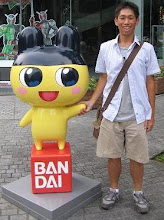2007年8月23日
今週の漢字: 正(の)
Positive:
My experience so far has been very positive. However, that’s not the reason why I decided to use this kanji for this week’s blog. I recently learned this kanji as I have been slowly spending time studying Japanese by myself. I use some Nintendo DS games to help me practice and even to learn more kanji. If I didn’t use the DS, I would be using so much paper for my kanji practicing. With the DS game, I can just write on the screen. As I walk around I try to recognize any kanji that I’ve already studied. I also try to read everything I come across whether it is hiragana, katakana, or even kanji. I would do something similar when I learn new grammar points. For example, I just recently learned about the products of interrogatives combined with particles. For どこ (doko = where), when it is added with certain particles, nouns are formed:
どこか (dokoka = somewhere); か (ka) is a particle used for questions.
どこも (dokomo = everywhere); も (mo) is a particle used to express equal, same…
どこでも(dokodemo = anywhere); でも (demo) is used similar to the English “but.”
My explanations of these particles are only what I have learned about them so far. There may be more uses of these particular particles. I noticed that there will be more uses for も that I will learn sometime later.
There are three large cell phone (携帯電話 – けいたいでんわ – keitaidenwa [or just 携帯/けいたい/keitai for short]) companies in Japan: Softbank, AU (by KDDI), and Docomo (by NTT). When I learned the new grammar point, it hit me why NTT’s cell phone company is named Docomo.
I still haven’t explained why I chose this particular kanji despite all my positive experiences. Since I have arrived in Japan, I have been attending orientations and seminars. Currently, I am still part of an English seminar that requires participation from all the AETs (Assistant English Teachers) in my prefecture as well as many JTEs (Japanese Teachers of English). Each of this 5-day seminar (not consecutive days) focuses on a different topic. The first day dealt with icebreakers and classroom management. The second day focused on improvement of the students’ listening skills and ways to effectively teach customs and cultures. Days 3-5 will take place at the end of the week and the beginning of next week. I found that the most interesting was the period dealing with customs and cultures. I knew about some things like the “sempai-kohai” system (in other words, a vertical system versus many western cultures of a horizontal system) and using circles to note correct answers. However, I did not know that the check mark meant incorrect. I figured that if people here would form an “X” with both arms or sometimes with their fingers, then incorrect answers would be marked with an “X” like it is in America.
Another interesting cultural difference to note is representation of counting. I never thought about this small action. I tally when I use marks to represent counting. People in Japan apparently tally by using 正 as follows:

These small revelations have been making my time so far extra special. I hope these small sweet moments continue throughout my time in Japan, however long that will be.
I have posted earlier than usual again due to the English seminar. As an update on my communication status here, I have gotten my cell phone by signing up with Softbank. Because of Softbank, I have seen many pictures of Cameron Diaz as the company uses her image to try to sell their products. I hope there was no brainwashing involved. I like to think that I signed with Softbank because of the nice deal I get for signing up with Yahoo Broadband (Yahoo BB) at the same time. [Note: Softbank and Yahoo BB recently merged.] My modem will be delivered to me in the beginning of September, so I’ll have the internet then. If I decided to get my modem when I signed up, I would have had to pay for the month of August.
Stay tuned next week for another update!
今週の写真: 東京で写真をたくさん撮った。








Above are pictures of Tokyo.

Map title near Shinjuku Station;
Shinjuku is where the hotel is located

Curry Udon restaraunt

Yum... tomato-based curry udon...
Only ¥780 (about $6.73 USD)














3 comments:
woah the tally mark thingy's so weird !
aaand the whole checkmark thing
anyways,
that tomato-based curry udon looks like a sloppy serve of spagetti [:
i already got the pics of the stuff in the house
but i'll get the cars tomorrow,
since i'm going out with friends that dayy
- sarah
Geez how could u write so much about kanji?? haha, u're 1/2 noodles 1/2 human. btw, i finished ur cake. xD hehe
- hannah
The tally mark is not really news to me. I know people who use it and according to Wikipedia, "Chinese, Korean and Japanese tally marks use the five strokes of 正 which is the character meaning 'correct',
'proper', and 'honesty'."
-curtiss
Yes, it does mean all those things. In Japanese, you need to add some hiragana though to make it mean correct. Anyway, I didn't know that Chinese and Korean people used this particular character as well. I just never thought about tallying. That's nice that it isn't news to you, but this blog is also used as a cultural exchange of sorts. Many people, I imagine, do not really know or even think about the tallying difference.
Post a Comment